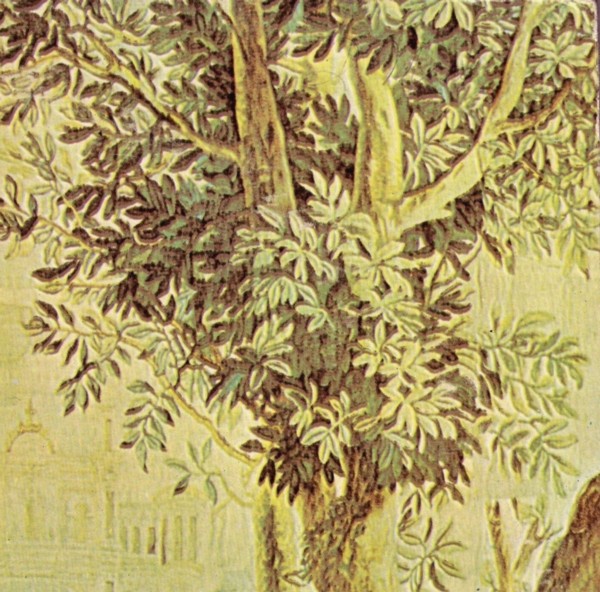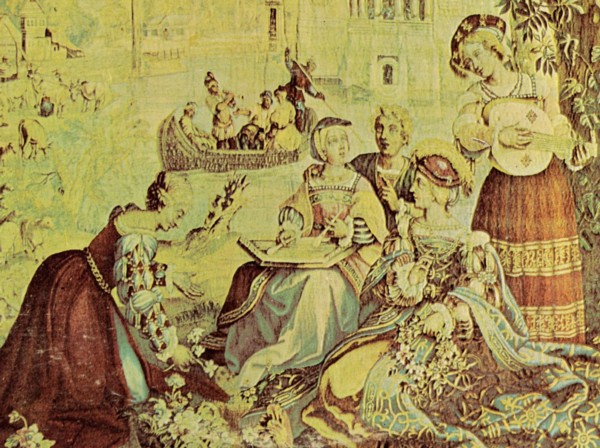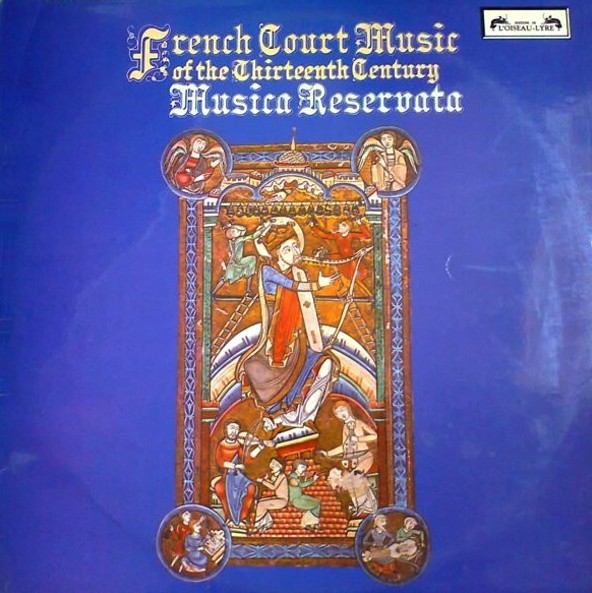
medieval.org
Everest 3270
1968
as "French Court Music of the Thirteenth Century":
Delysé 3201
L'Oiseau-Lyre SOL R 332
1968

medieval.org
Everest 3270
1968
as "French Court Music of the Thirteenth
Century":
Delysé 3201
L'Oiseau-Lyre SOL R 332
1968
A
1. Raimbaut de VAQUEIRAS. Kalenda maya [2:55]
mezzo-soprano, recorder, tenor rebec, drum, nakers
Adam de la HALLE
2. Taut con je vivrai [1:45]
3. Amours et ma dame aussi [0:56]
mezzo-soprano, counter-tenor, tenor, treble rebec, tenor rebec,
nakers
4. In seculum viellatoris [1:06]
treble rebec, tenor rebec, viol, harp
5. La quinte estampie real [1:03]
recorder, drum
6. Prisoner's song [5:21]
mezzo-soprano, tenor rebec, harp
7. La quarte estampie royal [2:37]
tenor rebec, viol, citole, large tabor
8. Adam de la HALLE. Robin m'aime [0:54]
mezzo-soprano, bagpipe
9. Mout me fu grief ~ Robin m'aime ~ Portare [1:41]
counter-tenor, mezzo-soprano, tenor rebec, harp
10. Amor potest ~ Ad amorem ~ Tenor [0:55]
counter-tenor, mezzo-soprano, tenor rebec, harp
B
1. Pucelete ~ Je langui ~ Domino [1:06]
counter-tenor, mezzo-soprano, tenor rebec, harp
2. Danse royale [1:22]
treble rebec, citole
3.
a) Jolietement [1:03]
baritone, tenor rebec, nakers
b) Au euer ai un mal ~ Ja ne m'en repentirai ~ Jolietement
[0:52]
tenor, tenor, baritone, crumhorn, tenor rebec, nakers
15. J'ai un cuer ~ Docebit [1:37]
mezzo-soprano, organetto
16. La seconde estampie royal [2:41]
shawm, drum
17. Flor de lis ~ Je nepu is ~ Douce dame [1:01]
tenor, tenor, baritone, 3 crumhorns
18. La sexte estampie real [1:14]
treble rebec, citole
19. Adam de la HALLE. Li dous regars [1:18]
tenor, tenor, baritone, 3 crumhorns, nakers
20. Dance. Ductia [2:24]
treble rebec, viol, nakers
21. Gaces BRULLES. De bone amor [7:14]
tenor, viol
22. On parole ~ A Paris ~ Frese nouvele [1:26]
tenor, tenor, baritone, shawm, large tabor

Musica Reservata
John Beckett, conductor
John Beckett & Michael Morrow, musical directors
Jantina Noorman, mezzo-soprano
Grayston Burgess, counter-tenor
Nigel Rogers, tenor
Edgar Fleet, tenor
Geoffrey Shaw, baritone
Ruth David, treble rebec
Daphne Webb, tenor rebec
Desmond Dupré, viol
Michael Morrow, crumhorn & bagpipe
David Munrow, crumhorn & shawm
Tess Miller, crumhorn
John Sothcott, recorder & citole
Brian Wilson, harp
John Beckett, citole, drum & organetto
Jeremy Montagu, nakers & large tabor
produced by Isabella Wallich
production liaison, Francis Grubb
cover design by Edwin Francis

To TALK of a "piece of music", in context of the 13th century, is
misleading. The performances on this record are like action
photographs—each captures a moment in the evolution of a piece
which was constantly changing. The moment has been crystallized by its
being written down at a particular place and point in time. The impulse
to write it down was usually extra-musical, certainly not because the
piece had reached "perfection", and the music itself continued its
process of adaptation: a note change here and there, a phrase re-cast
or an ornament added, a new text or an extra voice fitted.
Thus Jolietement mi tient li mal [B3] was a solo song (a
rondeau) in its own right, but at some stage it acquired two extra
voices with quite different words. It was written down thus at least
five times, each slightly differently, in France, Italy, Germany and
England.
Frese nouvele! ("Fresh strawberries!") and Muere france!
("honest blackberries!") were street-cries of Paris, for they recur
almost note-for-note a century later, in a motet picturing a Parisian
market-scene. As performed here [B11], they are joined by two upper
voices singing the praises of city life and the pleasures of Paris.
Three melodies so combined were often utterly contrasting in character.
So Pucelete Bele [B1] has a slow-moving bottom voice (a piece
of plainsong, "Benedicamus Domino") plodding in equal notes, a lusty
middle voice and a chattering top part (sung here only the second time
through). Douce dame cui j'aim tant was evidently a song in its
own right before it acquired two upper voices Flor de lis/Je ne puis
[B6]; what is more, those two extra voices fit just as well over a
completely different melody, Proh dolor, in another manuscript.
Even the idea of a single piece evolving is a vast oversimplification:
13th-century music is a complex network of intersecting lines. A snatch
of plainsong might be used over and over again, combined with other
melodies. This was true of the phrase "portare" (Alleluia: dulce
lignum) by the end of the century. Meanwhile, Adam de la Halle (c.
1237-86), who had left his home town of Arras in 1283 for Naples, wrote
there his celebrated pastoral play Le jeu de Robin et de Marion,
whose opening song is Robin m'aime. Yet a third tune, Mout
me fu grief, appeared many times over in manuscripts. But at one
point in their development these three tunes were combined together to
make a motet [A9]. (Compare the different ornaments of A8 and A9.) At
times, the elements of this music have a mobile-like existence in which
every "piece" is a quodlibet.
The remainder of the music here performed consists of secular songs and
instrumental pieces. Four of the songs are solo: one, an estampida,
from the troubadour Raimbaut de Vaqueiras (1155-1207) [A1], one from
the trouvère Gaces Brulles [B 10], one bilingual (the same text
in French and English) [A6], and the rondeau of Adam de la Halle [A8],
who is also represented by some 3-part songs [A2, A3, B8]. Of the
instrumental piece's, five are solo tunes from a collection of "danses
royales" [A5,7; B2,5,7] and one is a 2-part dance with the tune
underneath [B9].
The estampie was regarded as a "difficult" type of melody, and "because
of its difficulty it takes command of the heart of performer and
listener alike, and diverts the minds of the rich from depravity".

This is a record which explains those
packed houses on the South Bank for mediaeval music concerts. It would
be thin blood indeed which did not warm to the vitality of the very
first piece Kalenda maya, played and sung with such spirit, and more
likely than not you may find yourself whistling snatches of a Royal
Estampie before long. But first a word of warning for for those who do
not know the Musica Reservata style. The sounds they make are very
different from those we are accustomed to. Not that the instrumental
timbres will cause much difficulty. Rebecs are merely stringed
instruments which make a thinner, un-vibratoed sound than modern
violins; shawms and crumhorns are not all that different from modern
double reed instruments. The real shock comes with the voices. The
theory is that modern vocal technique is quite unsuitable for this kind
of music, and Thurston Dart essayed the idea years ago that if we look
at paintings of singing angels in mediaeval times, the strained
expression on their faces is totally unlike that of today's singers.
Add on the references to singing such as Chaucer's Prioress who, it
seems, sang through her nose, and some experiments in producing nasal
tone seemed valid.
The results can be heard in Jantina Noorman's singing on this record.
The tone quality is not unlike that of rustic itinerants in Italy to
this day, and reactions to its appearance in serious music vary from
amusement to outrage. Heard on this record, which gives you time to get
accusttomed to it, it becomes quite acceptable, at least for some
pieces. Its cutting edge suits Kalenda maya extremely-well, and all
other works where virility is the essence of the music. I find it
slightly less convincing in the more sentimental music, such as I
imagine the Prisoner's song might be, and also in vocal ensembles where
it tends to obliterate other voices (in the multi-text
Pucelete—Je langui—Domino, for example, the uppermost voice
of the countertenor is obscured). But it is always exciting, as is the
rest of the singing on the disc.
The playing on the whole is also good. The trouble with rebecs is that
they are often made to produce squeals and bumps which no one can like.
If there is the odd squeal on this record, nearly all of the sound is
entirely acceptable. The crumhorns are also made to produce a more
musical tone than the bee-like buzzing of the early days of their
revival, and David Munrow's playing in the Seconde estampie royal on
the shawm is most attractive.
Music of this period is so sketchily notated that it cannot be
separated from its modern arrangements. In the troubadour songs, for
example, the only music surviving is a series of notes without
indication of rhythm (though that can be deduced with some detective
work) or what played with the voice, if anything (and for this,
detection mainly means guesswork). The modern dressing up of the pieces
by, presumably, Messrs Morrow and Beckett, has an authentic ring about
it. Perhaps the harp in the Prisoner's song has a faintly Ravelian
flavour, and the percussion is sometimes a trifle overused. Otherwise
it sounds entirely possible.
One small grumble; no texts or translations seem to be provided, and
unless your mediaeval French is in good shape, you will have no idea
what the words are about (tracking down even some of the pieces in a
modern edition is a specialist's job). All the same, try out this
record, even if you do not know anything about this kind of music. It
is most exhilarating. — D.A., http://www.gramophone.net/Issue/Page/November%201968/105/848621
